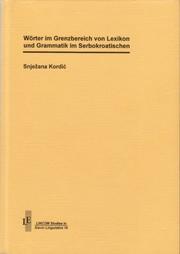Check nearby libraries
Buy this book

The first chapter of the book deals with the semantic, grammatical and pragmatic characteristics of the personal pronouns. It also deals with the peculiarities of the third person personal pronoun and its relationship to the demonstrative pronouns. The polite form of the personal pronoun is discussed in the second chapter. A type of generalisation by means of the word čovjek (‘one’; German ‘man’) is analysed in the third chapter. In the fourth chapter, the demonstrative pronouns in Serbo-Croatian ovaj ‘this’, taj ‘that’ and onaj ‘that’ are compared with their respective equivalent pronouns in Polish, Czech and Russian. The fifth chapter is devoted to the demonstrative words evo/eto/eno ‘behold, here is’. The sixth chapter examines the syntactic and semantic peculiarities of Serbo-Croatian composite conjunctions in comparison with German, Russian, Polish and Czech. In the seventh chapter, information is given regarding the grammatical and lexicographic description of the existentially used verbs imati (habere) and biti (esse) in Serbo-Croatian. In the last chapter, the meanings and grammatical features of the full and modal verb trebati ‘need/should’ are described.
Check nearby libraries
Buy this book

Subjects
Grammar, Syntax, Lexicography, Linguistics, Research, Vocabulary, Comparative Grammar, Particles, Statistics, Spoken Serbo-Croatian, Spoken Croatian, Sociolinguistics, Speech, Verb, Verbs, Existential constructions, Auxiliary verbs, Modality, Modality (Linguistics), Conjunctions, Agreement, Noun, Nouns, Adverb, Pronoun, Clauses, Relative clauses, Subordinate constructions, Sentences, Reflexives, Language, Language and languages, Semantics, Discourse analysis, Pragmatics, Anaphora (Linguistics), Slavic languages, Negation, Quantifiers, Morphology, Word order, Noun phrase, Deixis, Comparative and general Grammar, Possessives, Demonstratives, Corpora (Linguistics), Case, Croatian, Serbian, Serbo-Croatian, Croatian language, Serbian language, Serbo-Croatian language, Belarusian language, Czech language, Ukrainian language, Spanish language, Slovak language, Slovenian language, Russian language, Polish language, Macedonian language, French language, English language, French, English, Polish, Bulgarian language, German languageShowing 1 featured edition. View all 1 editions?
| Edition | Availability |
|---|---|
|
1
Wörter im Grenzbereich von Lexikon und Grammatik im Serbokroatischen
2001, Lincom Europa
Paperback
in German
3895869546 9783895869549
|
aaaa
Libraries near you:
WorldCat
|
Book Details
Table of Contents
Edition Notes
Includes diagrams, bibliographical references, and indexes.
Summary also in English (p. 259-266).
Classifications
The Physical Object
ID Numbers
Community Reviews (0)
Feedback?History
- Created October 29, 2008
- 16 revisions
Wikipedia citation
×CloseCopy and paste this code into your Wikipedia page. Need help?
| November 14, 2023 | Edited by MARC Bot | import existing book |
| December 13, 2020 | Edited by MARC Bot | import existing book |
| April 17, 2014 | Edited by Marta Juric | Edited without comment. |
| April 17, 2014 | Edited by Marta Juric | Edited without comment. |
| October 29, 2008 | Created by ImportBot | Imported from University of Toronto MARC record |










